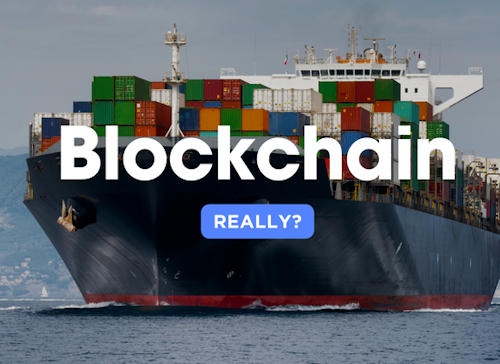Is Blockchain just a lot of Hoopla?

Blockchain technology is often associated with cryptocurrencies like Bitcoin, but its potential applications extend far beyond digital money. In the maritime shipping industry, blockchain is emerging as a transformative tool that can significantly enhance transparency and efficiency. By leveraging a decentralized and immutable ledger, blockchain technology addresses some of the industry's most pressing challenges, such as cargo tracking, documentation, and fraud prevention. Today we explore how blockchain actually improves these aspects and more, comparing traditional methods with blockchain solutions to highlight the advantages and potential of this innovative technology in maritime shipping.
Let's jump right in!
| ShipUniverse Summary: Blockchain in Maritime Shipping | ||
|---|---|---|
| Aspect | Traditional Method | Blockchain |
| Cargo Tracking | Relies on paper documents and isolated digital systems, making it difficult to track cargo accurately. | Real-time tracking with a decentralized ledger accessible to all parties, reducing lost or delayed shipments. |
| Documentation and Compliance | Often paper-based and prone to errors, delays, and fraud. | Digitized, tamper-proof documents accessible to all stakeholders, speeding up the process and ensuring compliance. |
| Fraud and Errors | Susceptible to fraud and errors due to lack of transparency and secure verification methods. | Decentralized ledger reduces the risk of fraud and errors by providing a transparent and secure way to verify transactions. |
| Payments and Financial Transactions | Involves multiple intermediaries, leading to delays and increased transaction costs. | Smart contracts enable faster and more secure payments, reducing the need for intermediaries. |
| Supply Chain Visibility | Disjointed systems make it difficult to get a complete picture of the supply chain. | End-to-end visibility with a unified ledger, enhancing coordination and reducing disruptions. |
| Dispute Resolution | Time-consuming and costly, requiring extensive documentation and legal intervention. | Transparent records provide clear evidence, simplifying and speeding up dispute resolution. |
| Customs Clearance | Slow and paper-intensive, often leading to delays at ports. | Real-time access to digitized documents speeds up verification and reduces delays. |
| Traceability of Goods | Difficulty in accurately tracing the origin and journey of goods. | Detailed tracking from origin to destination, ensuring quality control and quick issue resolution. |
| Collaboration and Data Sharing | Fragmented and inefficient, often relying on emails, faxes, and isolated databases. | Unified platform for data sharing, enhancing coordination and reducing communication errors. |
| Security | Vulnerable to cyberattacks and unauthorized access. | Decentralized and cryptographic nature ensures high security and tamper-proof data. |
| Administrative Costs | Labor-intensive and costly administrative processes. | Automated and digitized processes reduce the need for manual intervention, lowering costs. |
| Compliance and Auditing | Time-consuming and prone to human error. | Clear and accurate audit trail simplifies compliance and auditing processes. |
| Trust Among Stakeholders | Discrepancies and lack of transparency can lead to mistrust. | Transparent and accurate information builds trust among all parties. |
| Automated Transactions | Requires manual processing and multiple intermediaries, slowing down transactions. | Smart contracts automate transactions, making them faster and more efficient. |
1. Improved Cargo Tracking
How It Helps: Blockchain allows for real-time tracking of cargo shipments. Each transaction or movement of cargo is recorded in a decentralized ledger that all parties can access.
Why It’s an Improvement: Traditional methods rely on paper documents and isolated digital systems, making it difficult to track cargo accurately. With blockchain, every transaction is securely recorded and visible to all stakeholders, reducing the risk of lost or delayed shipments.
2. Enhanced Documentation and Compliance
How It Helps: Blockchain can streamline the documentation process by digitizing contracts, bills of lading, and other essential documents. Smart contracts, which automatically execute terms when conditions are met, can also be used.
Why It’s an Improvement: Current documentation methods are often paper-based and prone to errors, delays, and fraud. Blockchain’s immutable ledger ensures that documents are tamper-proof and easily accessible, speeding up the process and ensuring compliance with regulations.
3. Reduced Fraud and Errors
How It Helps: Blockchain’s decentralized nature means that no single party can alter the data without consensus from the network. This reduces the risk of fraudulent activities and errors in the shipping process.
Why It’s an Improvement: Fraud and errors are significant issues in maritime shipping, leading to financial losses and disputes. Blockchain provides a transparent and secure way to verify transactions, ensuring the integrity of the shipping process.
4. Streamlined Payments and Financial Transactions
How It Helps: Blockchain enables faster and more secure financial transactions. Payments can be processed through smart contracts, which automatically release funds when predefined conditions are met.
Why It’s an Improvement: Traditional payment methods in maritime shipping often involve multiple intermediaries, leading to delays and increased transaction costs. Blockchain reduces the need for intermediaries, speeding up the payment process and lowering costs.
5. Better Supply Chain Visibility
How It Helps: Blockchain provides end-to-end visibility of the supply chain. Each step of the shipping process, from production to delivery, is recorded on the blockchain, allowing all parties to see the status and location of goods in real time.
Why It’s an Improvement: Current supply chain management systems can be disjointed, making it difficult to get a complete picture of the process. Blockchain’s unified ledger provides a single source of truth, enhancing coordination and reducing the risk of supply chain disruptions.
6. Efficient Dispute Resolution
How It Helps: Blockchain creates a transparent and tamper-proof record of transactions and agreements. In the event of a dispute, parties can refer to the blockchain to verify the details of the transaction and resolve issues more quickly.
Why It’s an Improvement: Disputes in maritime shipping can be time-consuming and costly, often requiring extensive documentation and legal intervention. Blockchain’s transparent records provide clear evidence, simplifying the dispute resolution process and reducing associated costs.
7. Enhanced Customs Clearance
How It Helps: Blockchain can streamline the customs clearance process by providing authorities with real-time access to shipping documents and cargo information. This can include digitized certificates of origin, invoices, and other necessary paperwork.
Why It’s an Improvement: Traditional customs clearance processes can be slow and paper-intensive, often leading to delays at ports. Blockchain reduces the need for physical documents, speeds up verification, and ensures that all necessary information is readily available, reducing delays and improving efficiency.
8. Increased Traceability of Goods
How It Helps: Blockchain allows for detailed tracking of goods from the point of origin to the final destination. Each stage of the journey is recorded, providing a transparent and immutable trail.
Why It’s an Improvement: Current systems can struggle with accurately tracing the origin and journey of goods, especially in complex supply chains. Blockchain enhances traceability, making it easier to verify the provenance of goods, ensure quality control, and quickly address issues such as recalls or contamination.
9. Improved Collaboration and Data Sharing
How It Helps: Blockchain facilitates better collaboration among all parties involved in maritime shipping, including shippers, carriers, ports, and customs authorities. Shared access to a decentralized ledger ensures that everyone has the same information, reducing misunderstandings and discrepancies.
Why It’s an Improvement: Traditional methods of data sharing can be fragmented and inefficient, often relying on emails, faxes, and isolated databases. Blockchain provides a unified platform for data sharing, enhancing coordination, reducing communication errors, and improving overall efficiency.
10. Enhanced Security
How It Helps: Blockchain's decentralized and cryptographic nature ensures that data is highly secure and tamper-proof. Each transaction is encrypted and linked to the previous one, creating an immutable record.
Why It’s an Improvement: Current data management systems can be vulnerable to cyberattacks and unauthorized access. Blockchain significantly enhances security, reducing the risk of data breaches and fraud.
11. Reduced Administrative Costs
How It Helps: By automating and digitizing many administrative tasks through smart contracts and blockchain ledgers, the overall administrative workload is reduced.
Why It’s an Improvement: Traditional administrative processes are often labor-intensive and costly. Blockchain streamlines these processes, reducing the need for manual intervention and lowering operational costs.
12. Facilitated Compliance and Auditing
How It Helps: Blockchain provides a transparent and easily accessible record of all transactions and movements, making it simpler to demonstrate compliance with regulatory requirements.
Why It’s an Improvement: Auditing and compliance checks using traditional methods can be time-consuming and prone to human error. Blockchain ensures a clear and accurate audit trail, simplifying the process and reducing the likelihood of errors.
13. Increased Trust Among Stakeholders
How It Helps: Blockchain builds trust by providing a single source of truth that all parties can rely on. This transparency helps in fostering better relationships among stakeholders, including shippers, carriers, insurers, and customers.
Why It’s an Improvement: Traditional methods can lead to disputes and mistrust due to discrepancies and lack of transparency. Blockchain ensures that all parties have access to the same accurate information, reducing conflicts and increasing trust.
14. Support for Automated Transactions
How It Helps: Smart contracts on the blockchain can automate various transactions and processes, such as payments, insurance claims, and cargo releases, without the need for intermediaries.
Why It’s an Improvement: Current systems often require manual processing and multiple intermediaries, which can slow down transactions and increase costs. Blockchain automates these processes, making transactions faster, more efficient, and less costly.

Do you have a Maritime Product or Service that may be of interest to Shipowners? Tell us about it here!
Do you have feedback or insights? Please reach out to editor @ shipuniverse.com



